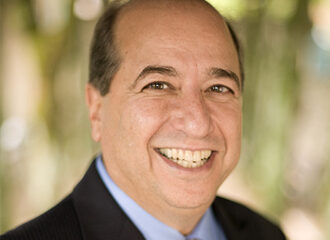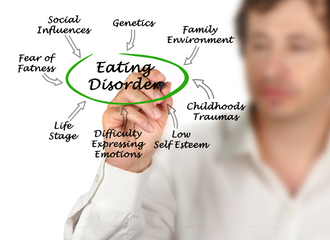Written by: Samantha DeCaro, PsyD
Director of Clinical Outreach and Education, The Renfrew Center

What is Binge Eating Disorder?
Binge Eating Disorder is the most common eating disorder diagnosis, and when compared to other eating disorders, gender and ethnic differences seem to be less pronounced.
BED is more prevalent than anorexia and bulimia combined, despite the widespread misconception that anorexia nervosa is the most common eating disorder. An individual with BED experiences recurrent episodes of binge eating, which means that the person is eating a very large amount of food in a discrete period of time (i.e., about 2 hours or less).
What Are the Symptoms of BED?
Currently there aren’t any caloric guidelines to what constitutes a binge episode; however, a difference between BED and NES is that a binge episode includes a significantly larger amount of food than what most people would eat in a similar timeframe. In addition, three or more of the following must be present for a BED diagnosis:
- Eating much more rapidly than normal
- Eating until uncomfortably full
- Eating large amounts of food when not physically hungry
- Eating alone because they feel embarrassed by how much they are eating
- Feeling disgusting with oneself, depressed or guilty after the binge episode
What is Different About BED?
Although BED and NES both can cause impairment and distress, another key difference between BED and NES is that those with BED report feeling a loss of control during the binge eating episode. These episodes must occur for at least once a week for three months (mild) but can be as extreme as fourteen times a week or more.
Unlike bulimia, there are no compensatory behaviors present, meaning that the person is not taking any action to “undo” or compensate for the binge episode (i.e., exercise, laxatives, purging, etc.). The Eating Disorder Examination (EDE) and the Eating Disorder Examination Questionnaire (EDE-Q) are both trusted screening tools for BED and other eating disorders. The EDE is administered by a professional, while the EDE-Q can be completed alone.
What Is Night Eating Syndrome?
Although Binge Eating Disorder is technically the most common eating disorder, NES has a similar rate of prevalence including a similar age of onset in the late teens and early adult years. It is listed under the Other Specified Feeding or Eating Disorder diagnosis (OSFED) in the DSM 5 due to its unique presentation compared to the other more well-known eating disorders.
NES shares some similarities with BED as both can cause significant distress or impairment in social situations, at work or in other important areas of functioning. Similar to BED, the cause of NES is not fully understood, although there seem to be genetic, biological and psychological factors at play. NES can also occur alongside anxiety, depression, sleep disorders, BED, or other ED diagnoses.
What Are the Symptoms of NES?
NES is characterized by repeated episodes of night eating, meaning that the individual will wake up in the middle of the night with the belief that they need to eat something to successfully fall back asleep. They also report experiencing a worsening mood in the evening hours with strong urges to eat between dinner and bedtime, as well as difficulty falling asleep.
Consequently, people with NES often report not feeling hungry enough to eat in the morning. The person is fully aware when they are eating, and they can remember each episode.
NES is not given as a diagnosis if these episodes can be better explained by substance use, a medical disorder, medication side effects, changes in sleep-wake cycle or by cultural norms.
How is NES Diagnosed?
The symptoms of NES can last for many years, with periods of remission and relapse that seem to be linked to various life stressors. The night eating questionnaire (NEQ) is an assessment tool used to screen for various NES signs, including lack of hunger in the morning and food cravings in the evening. The Night Eating Syndrome History and Inventory was subsequently used to diagnose NES.
Irregular Eating: A Common Denominator
There are three types of irregular eating that seem to contribute to the cycle of BED and NES:
- Delayed Eating: An example of this would be someone who wakes up without an appetite due to a previous binge episode or night eating episode. Also driven by guilt and shame, the person chooses to start the day with coffee and fast until lunch. This type of deprivation can easily set the individual up to crave food later in the day, engage in a binge episode, or eat in the middle of the night. If they do so, the person is left feeling like a failure, and these distressing emotions can result in repeating the cycle.
- Caloric Restriction or Dieting: Again, due to physical and mental deprivation, the person will likely experience urges to binge or eat at night. After breaking their diet rules, the person experiences guilt, motivating them to go back to the dieting cycle again.
- Food Labeling: Finally, labeling foods as “good” or “bad” can create a state of psychological scarcity, resulting in intrusive thoughts and intense urges to eat the forbidden foods. When the person inevitably gives in during a binge or night eating episode, the guilt and shame drive them back to consuming only the “good” food.
Conclusion
Part of the treatment plan for BED or NES should include structured meals with a variety of foods, including planned exposures to the fear foods previously labeled as “bad.” Therapy should also address improving the relationship with the body, as internalized fat phobia and weight stigma often drives the desire to restrict and eat irregularly.
There is also a theory that all emotional disorders, BED and NES included, are maintained by the avoidance of emotional experiences. The behaviors of binging or eating at night could be an attempt to dampen, numb, or completely avoid old and new emotional experiences. Effective treatment should emphasize the importance of accepting emotions mindfully, and without judgment, so that there are ample opportunities to learn that all emotional experiences are both temporary and tolerable.


